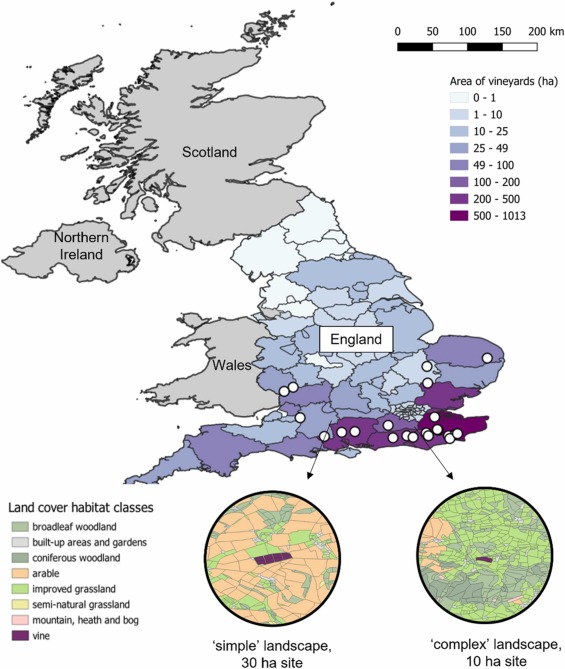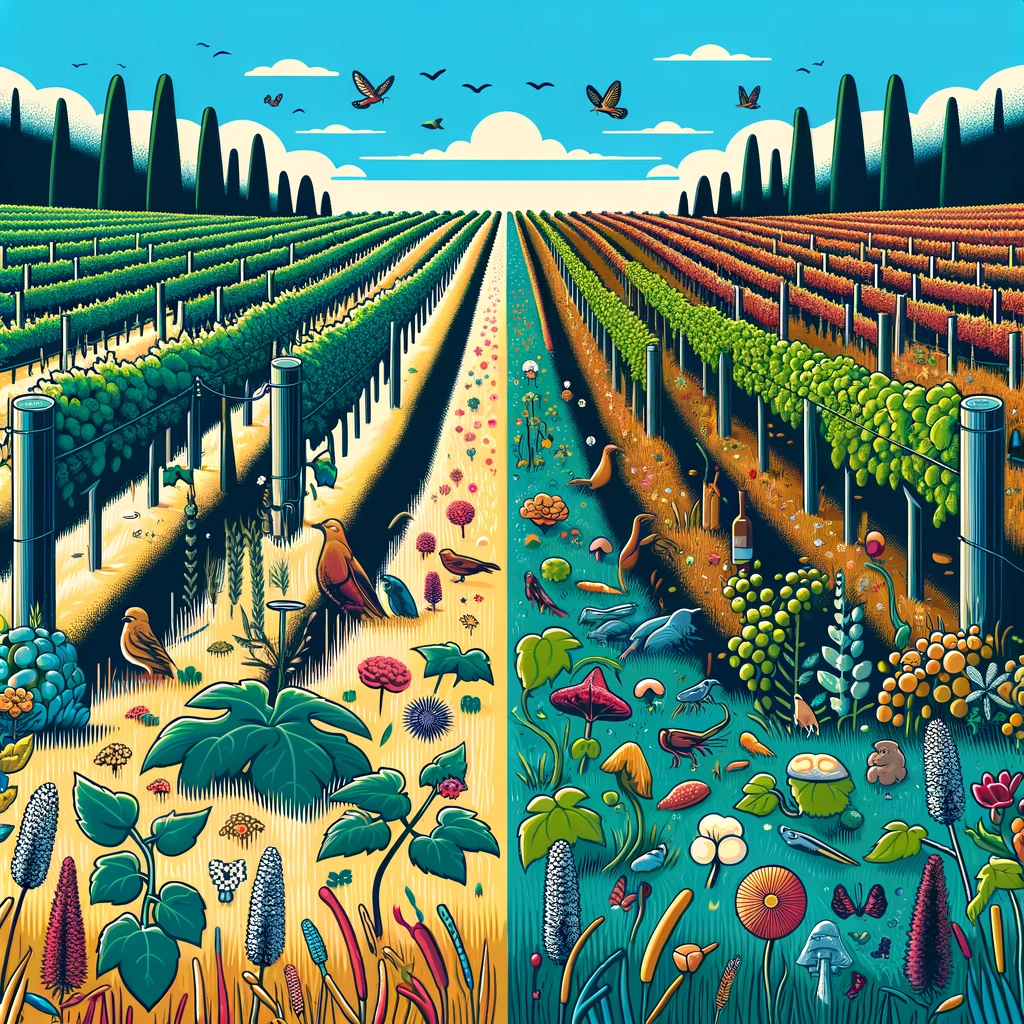Introduction
Habitat loss, landscape simplification and increased chemical use associated with agricultural expansion and intensification are major causes of biodiversity loss globally (Pereira et al., 2012, Newbold et al., 2016). A recent Europe-wide analysis found agricultural intensification, and particularly the associated agrochemical use, to be the main driver of most bird population declines (Rigal et al., 2023). Similarly, a global study found terrestrial arthropod abundance and biomass to have been steadily declining by ∼9% per decade, supporting strong declines in Europe and a negative relationship with land use change (van Klink et al., 2020). These declines not only risk extinctions of rare species, but also threaten the loss of key ecosystem functions that benefit agriculture (Hendershot et al., 2020).
Grapevines are an important global crop, with over 7 million hectares of land dedicated to their production, which accounts for about 5% of the global cover by perennial crops (Ritchie and Roser, 2013, Venkitasamy et al. 2019). At landscape scale, increased vineyard cover has been shown to have a detrimental effect on biodiversity, including on birds (Assandri et al., 2016, Pithon et al., 2016), bats (Rodríguez-San Pedro et al., 2019), and arthropods (Geldenhuys et al., 2022). However, maintaining habitat heterogeneity, through habitat retention and provision within vineyards can help offset these impacts (Winter et al., 2018, Paiola et al., 2020), particularly in more homogenous landscapes where resources are otherwise limited (Assandri et al., 2016, Martin et al., 2019). For example, retention of native woodlands and hedgerows within Swiss (Guyot et al., 2017), German (Rösch et al., 2023), and Chilean vineyards (Steel et al., 2017, Muñoz-Sáez et al., 2020) enhanced bird abundance and diversity, whilst wildflower mixes and reduced mowing that increased ground vegetation cover benefited arthropod and bird diversity in European (Puig-Montserrat et al., 2017, Griffiths-Lee et al., 2023) and South African vineyards (Geldenhuys et al., 2022). Studies from Europe (Brambilla et al., 2017), and South America (Muñoz-Sáez et al., 2020) have also demonstrated the potential for vineyards to support high abundances of threatened and endemic bird species.
The viticultural industry faces pressure to move towards more environmentally sustainable management (Merot et al., 2019, Barbaro et al., 2021), intensified by the new Global Biodiversity Framework, which sets a target to manage agricultural landscapes sustainably, ‘including through a substantial increase of the application of biodiversity friendly practices’ (Keping, 2023). Managing agricultural landscapes in ways that are less detrimental to biodiversity is often encouraged through agri-environmental schemes and accreditations, and rewarded through compensation or higher product prices (Tscharntke et al., 2012, Boetzl et al., 2021). Globally, organic farming has been shown to enhance species richness on agricultural land by an average of 30%, though this positive effect is greater in more homogenous and intensively-managed agricultural landscapes (Tuck et al., 2014).
In the UK, the viticultural industry is the fastest growing agricultural sector, attributed to increasing summer temperatures making the climate increasingly comparable to other European wine-growing regions (Nesbitt et al., 2019). Due to the recent expansion, specific recommendations for UK viticulture are lacking, and research is limited, though a recent industry survey found heavy reliance on agrochemicals (Griffiths-Lee et al., 2022). To address this, a national sustainability scheme called Sustainable Wines of Great Britain (henceforth ‘SWGB’) has been formed and over 80 vineyards, accounting for over 55% of the UK’s vineyard hectarage, are now members (WineGB, 2022). This scheme strives to ensure environmental, social, and economic sustainability within the industry through a process of continual improvement (WineGB, 2022). It lacks minimal requirements or specific targets, but rather provides broad recommendations such as “create new habitats in order to increase biodiversity, such as hedges”, and members commit to a continual cycle of improvement towards sustainability, with minimal agrochemical use and biodiversity conservation strongly encouraged.
By working in multiple English vineyards spanning a range of management practices, and also varying in the structure of their surrounding landscapes, we provide the first simultaneous assessment of the effects of surrounding semi-natural habitats and management on vineyard biodiversity. Our aims were: (1) to assess the relative impact of surrounding habitat structure and vineyard management on bird and arthropod abundance and diversity, and (2) to compare bird and arthropod abundance and diversity between certified-organic and non-organic vineyards, and based on SWGB accreditation status. Due to their differing mobility, we predict surrounding semi-natural habitats to have a stronger effect on birds than on arthropods, while in contrast we predict arthropods to be more strongly affected by vineyard management, including organic viticulture, which we expect to have an overall positive effect on biodiversity.
Material and Methods
The study described in this text was an extensive research project conducted across 22 vineyards in the UK with the aim of exploring the impact of vineyard management practices and landscape structure on biodiversity. The vineyards were selected to represent a wide range of conditions, including both organic and non-organic farming practices, and varied in size and landscape complexity.

Fig. 1. Map of the UK showing the area, in hectares, of commercial vineyards per county in England. White circles indicate study sites. Examples of two 2.5 km landscape buffers from contrasting landscapes are shown. Hectarage data were from EnglishWine.com, compiled by Stephen Skelton.
The key elements of this study are as follows.
Vineyard Selection: Vineyards were chosen across the UK’s major wine-growing regions, ensuring a mix of organic and non-organic sites, as well as those accredited through the Sustainable Winegrowing Great Britain (SWGB) scheme. The selection was based on a set protocol that emphasized landscape diversity and different management styles. Vineyards need to meet certain criteria, such as location, grape variety, establishment year, and size.
Biodiversity Sampling: The study focused on sampling bird and arthropod communities in 2021 and 2022. Bird populations were assessed using point counts across various locations within the vineyards and arthropod communities were examined using pitfall traps set along transects in the vineyards.
Landscape and Management Characterization: This study analyzed the landscape structure around vineyards, including the cover of different land types and the presence of water bodies. The management practices of vineyards were also examined, focusing on aspects such as chemical inputs, ground vegetation cover, and other management strategies that could affect biodiversity.
Data Analysis: The collected data were analyzed using a series of models to determine the relationship between vineyard management, landscape structure, and biodiversity. This analysis involved different statistical approaches for birds and arthropods, considering factors such as abundance, species richness, and diversity.
Results
The results of this study, conducted across 22 vineyards, provided valuable insights into bird and arthropod populations in these environments.
Bird Findings: This study recorded 6,853 individual birds from 61 species, including 15 red-listed species. Notably, bird abundance was not significantly different between organic and non-organic vineyards, or between SWGB-accredited and non-SWGB vineyards. However, bird abundance was higher during the flowering and harvest seasons than that during the budding season. Interestingly, landscape and local semi-natural habitats as well as vineyard management practices did not significantly affect bird abundance. Bird species richness was lower in SWGB-accredited vineyards than in non-SWGB vineyards and higher during the harvest season than during the budding season. Shannon diversity was lower in SWGB vineyards and was affected by season, being lower during harvest than during budding. Ground vegetation cover positively influenced Shannon diversity at both landscape and local scales. Conversely, higher ecotoxicity scores were associated with lower Shannon diversity.
Arthropod Results: In terms of arthropods, 1,679 pitfall traps were deployed, catching 8,726 individuals across 19 orders. The probability of arthropod presence was higher during the flowering and harvest seasons but lower in 2022 than in 2021. Factors such as distance from the field edge, practice score, and ground vegetation cover significantly influenced the presence of arthropods. Arthropod abundance was higher in organic vineyards and was positively affected by the practice score and vegetation cover, but negatively affected by higher ecotoxicity scores. Similarly, the Shannon diversity of arthropods was higher with increased vegetation cover and lower with higher ecotoxicity scores.
Management Differences: Regarding vineyard management, organic vineyards had significantly lower ecotoxicity scores than non-organic vineyards. The Practice scores were higher for the non-SWGB vineyards. There were no significant differences between the vineyards under different management regimes in terms of mowing, cultivation frequency, or overall ground vegetation cover. However, the ground vegetation cover was higher in vineyards that did not use herbicides and decreased with field size.

Discussion
In the Discussion section of the study, the key finding was that vineyard management practices, rather than the surrounding semi-natural habitats, were the primary factors influencing bird and arthropod biodiversity in English vineyards. This study revealed that organic certification and sustainability accreditation (SWGB) were not necessarily indicative of higher biodiversity. Specifically, organic vineyards had positive impacts on arthropod abundance, whereas SWGB-accredited vineyards had lower bird diversity.
The researchers highlighted that the effects of organic viticulture on bird diversity have been mixed in Europe, with some studies reporting positive effects and others, such as this one, finding no significant impact. The study suggested that including plant diversity in future research might reveal stronger effects of organic viticulture, as plants often benefit more from organic practices than from mobile organisms. It was also noted that the species in English vineyards might be generalists who are less sensitive to farming practices, given the changes in farmland biodiversity due to agricultural intensification.
Key findings included:
Chemical Use and Ecotoxicity: SWGB-accredited vineyards had higher ecotoxicity scores, which were negatively associated with biodiversity. Organic vineyards used fewer chemicals, resulting in lower ecotoxicity scores, but the frequency of chemical applications did not differ significantly from that of non-organic sites. This frequency of application, especially in organic vineyards, can negate the potential biodiversity benefits.
Ground Vegetation Cover: This had a strong positive effect on biodiversity. Herbicide use decreased vegetation cover and increased ecotoxicity scores. The study also found that ground vegetation cover was lower in vineyards with larger fields, possibly because of more intensive management.
Vine Cover: Increased vine cover was linked to reduced bird diversity, possibly because alternative habitats, such as hedgerows, provided important spaces for birds.
Implications for Management and Policy: The study suggests that individual management practices impact vineyard biodiversity more than the overall management regimes or surrounding habitats. Recommendations include managing the types and frequency of agrochemical applications and increasing the ground vegetation cover by eliminating herbicides and sowing diverse crops.
In summary, this study calls for a more nuanced approach to vineyard management, emphasizing the need to carefully select and apply agrochemicals and increase ground vegetation to enhance biodiversity. It also suggests that certification schemes, such as SWGB, need to evolve to more effectively reflect biodiversity-friendly practices.
Read all at: Zielonka, N. B., Shutt, J. D., Butler, S. J., & Dicks, L. V. (2024). Management practices, and not surrounding habitats, drive bird and arthropod biodiversity within vineyards. Agriculture, Ecosystems & Environment, 367, 108982.

